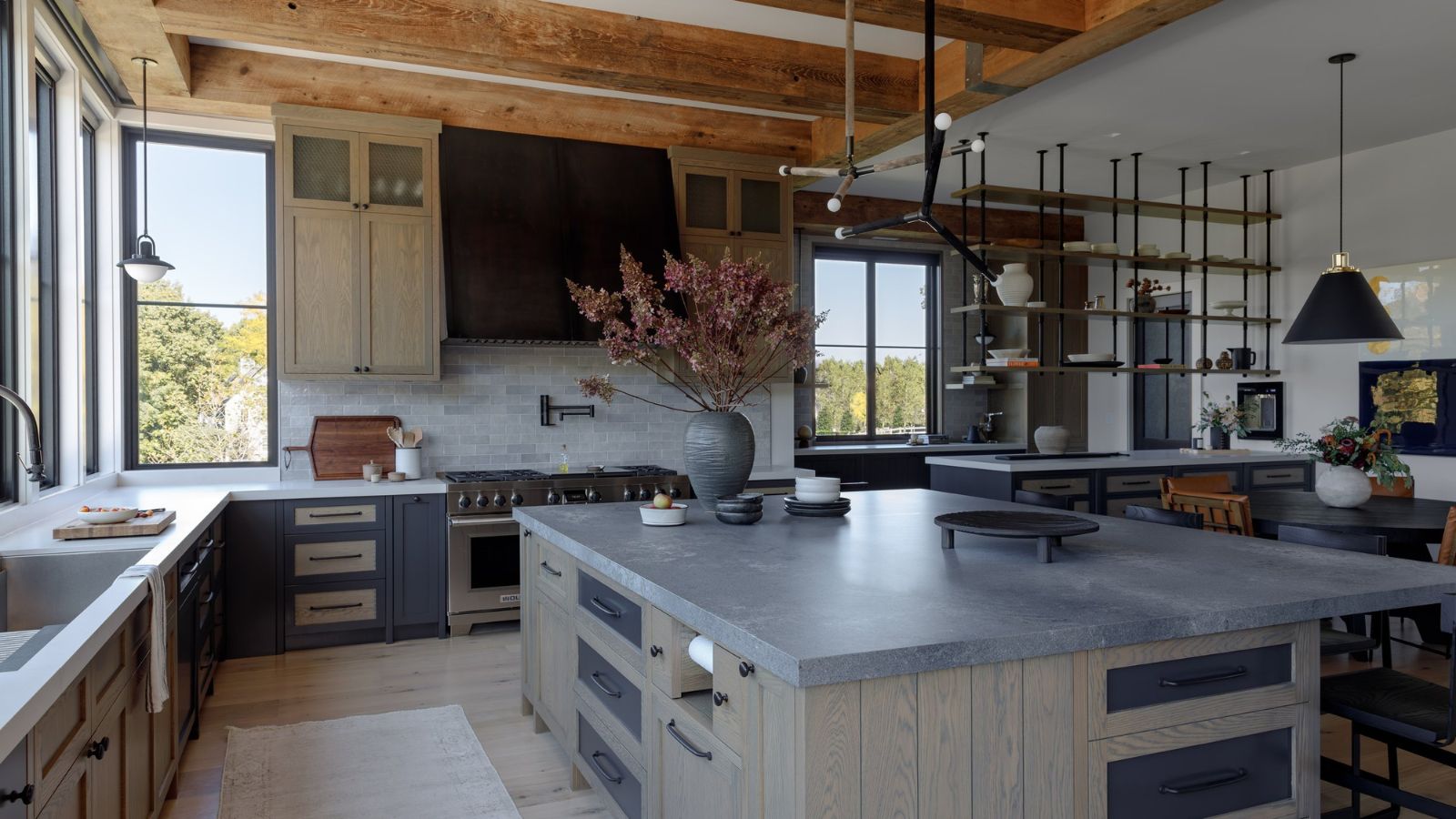
A good kitchen lighting scheme is key to the room's success. It's as important and as impactful as the colors, the cabinets, and the flooring, and, just like all of these features, it needs to get that perfect balance between style and function.
You need to be able to see what you're doing when cooking, yet you also want the space to feel calming and enhance the mood of you and your family as you use the room day after day, not just to cook, but also to relax in. After all, many of us have combined kitchen diners, and the uses of the dining table go beyond eating – it's a spot for reading in the morning, craft projects with kids, or afternoons working from home.
And, of course, you also want the potential to create ambiance in your kitchen as friends are sitting around your island. With all this in mind, it's worth being fastidious when it comes to planning the illumination of your cooking space, and this comprehensive list of inspiring kitchen lighting ideas is a useful starting point.
1. Always layer your kitchen lighting
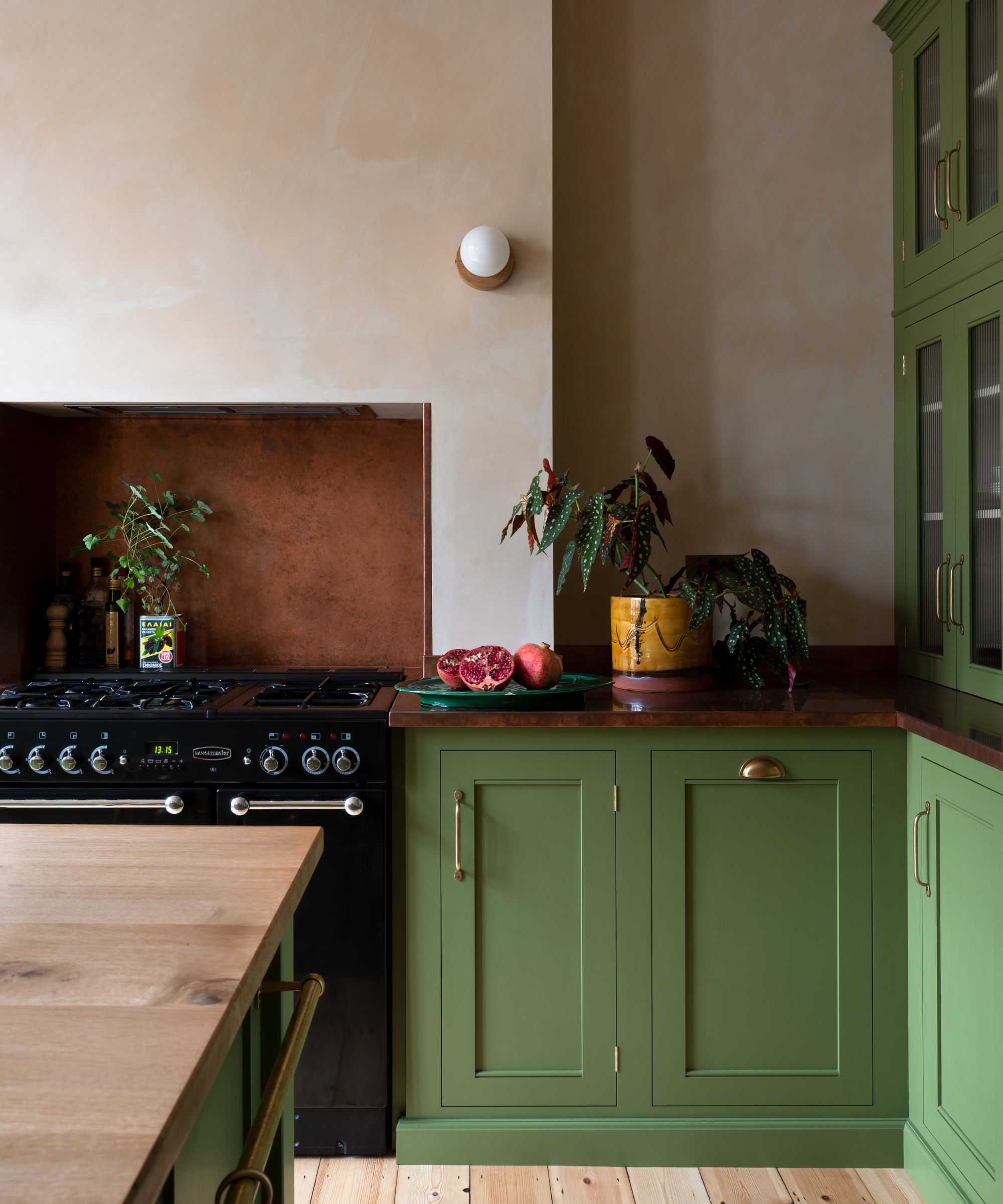
Knowing how to layer lighting is important in any room, but since the kitchen wears so many hats, having a different source and type of lighting for each task is key. You want to ensure each part of your kitchen is lit for the tasks it will face, which usually means a combination of pendant lights, wall lights, and even lamps to light specific surfaces.
As Helen Parker, Creative Director of deVOL explains, 'Always layer your kitchen lighting. Keep kitchen pendant lights subtle and not too overpowering, even though the urge to really make your mark with these is hard to resist. Don’t be set on the three lights over an island combination, try to be less obvious and go for simple, understated, and beautiful.'
'And make sure you have plenty of inset ceiling lights to give full-on light when needed, but as with all lighting, make sure you get dimmers fitted, they make so much difference to the atmosphere and function of a room. Wall lights are a great way of mixing up the feel of a kitchen, they seem to create a softer light and really give character to a room. I would always recommend wall lights in a kitchen.'
'Also, a few little occasional lights are nice for added atmosphere, a little pool of light in a dark corner is the perfect way to create lovely little spots in a room, an unexpected light and a little styling in an otherwise dark corner can be the making of a kitchen.'
2. Balance an island with large scale lighting

Large-scale lighting can play a balancing role in a room with a high ceiling, drawing the eye downwards to beautiful cabinetry and surfaces. ‘Here, a pair of oversized pendants makes a practical and elegant statement above the island,’ says Hannah Linford, senior studio lead at Sims Hilditch. ‘Their classic conical shape respects the form of the roof void and provides a soft light within the open-plan space.’
Positioning pendants above a kitchen island or table in an odd number is generally the rule. However, when the fittings are bigger than usual, it’s preferable to base the number on the island’s width, allowing around 23-25 inches between pendants and 5-7 inches from either end.
3. Incorporate a plug in task light
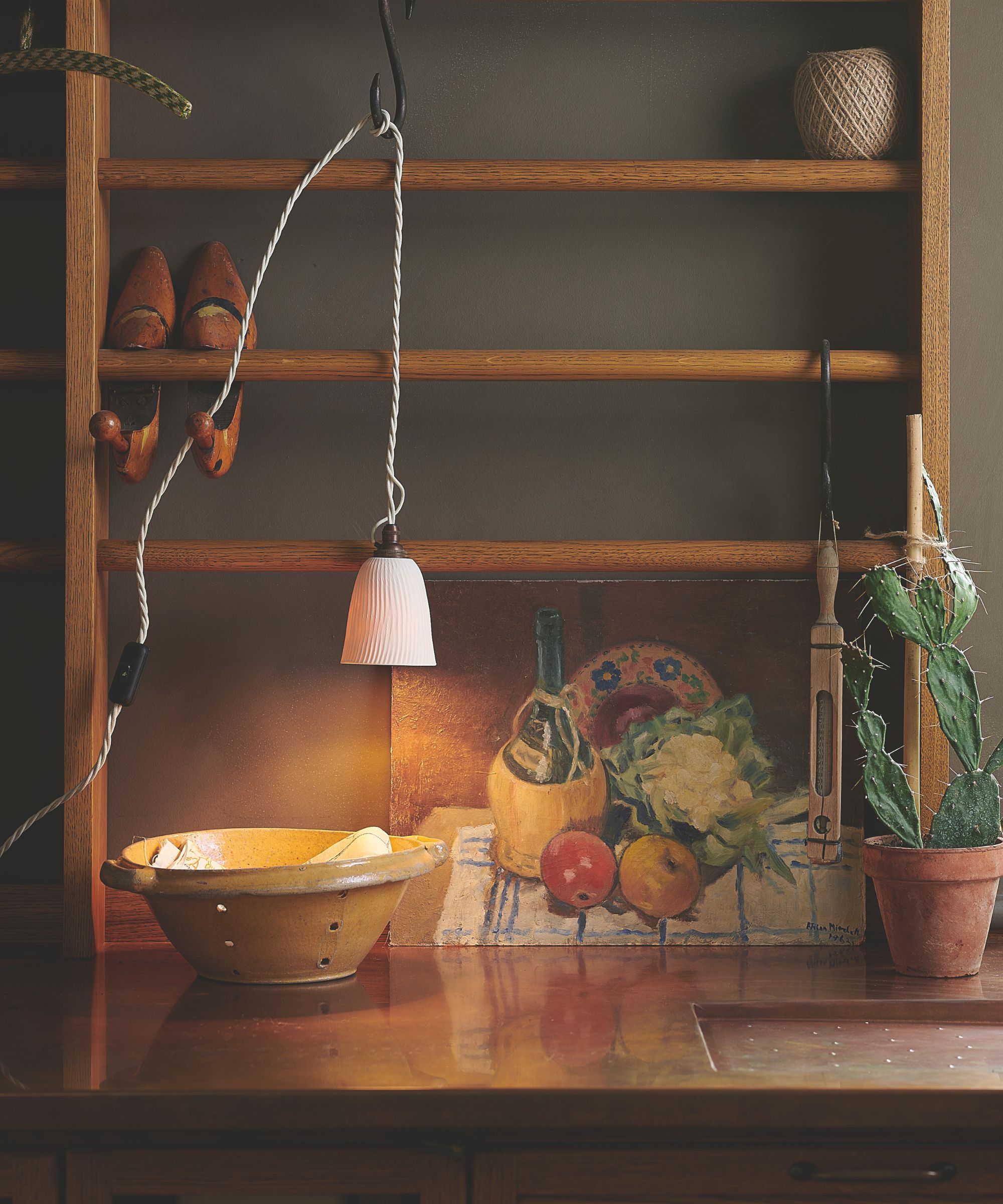
Plug-in lights are your flexible friend in the kitchen, offering versatility and ease of installation. They allow you to place lighting exactly where you need it, without the commitment of hardwiring. Perfect for adding accent lighting or brightening a dim area, their mobility also means you can switch up your lighting scheme easily as your kitchen layout evolves.
‘We love a plug-in light that can just appear in a once gloomy spot or in a newly organized corner of a kitchen, creating instant mood,’ says Helen Parker. ‘The ability to plug in a light source without the need for permanency can enhance your kitchen for a special occasion or specific purpose, but our guess is that once you have created an extra corner of moodiness, you won’t want to take it away.'
4. Or get on the trend for portable lamps
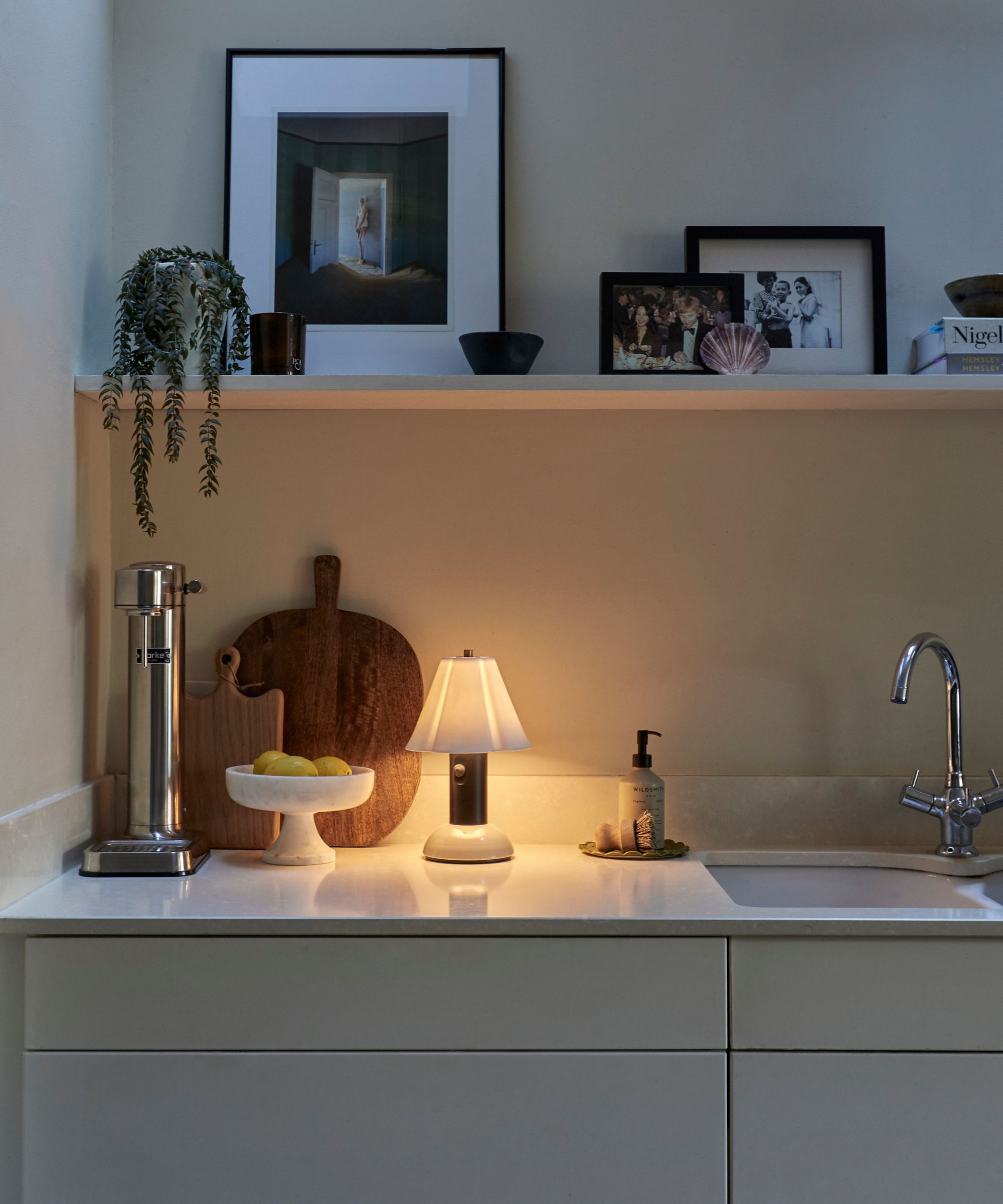
Portable lamps are a huge trend this year, and they have meant that you can be more flexible than ever with your kitchen lighting. You don't have to worry about wires or where your plugs are positioned.
The soft lamp light is perfect for when your kitchen shifts from cooking time to relaxing or socializing time. You can turn off the brighter task lights and switch on a few lamps around the space to create soft pools of light, much like you would find in much softer spaces like bedrooms or living room. Amazon stocks a huge array of portable lamps, and Anthropologie's viral Bobbin lamp is gracing all the most stylish kitchens right now.
5. Use your kitchen lighting to bring in contrasting styles

Contrast is what makes spaces interesting, bringing in something unexpected so your kitchen doesn't look too set in one style. Lighting is the perfect way to do this as it's far easier to introduce lighting that contrasts your kitchen cabinet style than say, tiles or flooring. Lighting is the perfect size to add interest without those different styles looking jarring.
It's exactly what designer Becky Shea has done in this modern rustic kitchen. The overall kitchen style leans farmhouse rustic with the wooden cabinetry and beams, but rather than go for a more traditional rustic kitchen lighting idea, Becky has added a statement contemporary piece that gives the whole room an edge.
6. Pick lighting that's a piece of art

Kitchens are very practical spaces; it can be hard to bring lots of decor into these hardworking rooms, so let your lighting double as decor by choosing a really beautiful fixture.
As Miami-based husband and wife design duo of Monica Santayana and Ronald Alvarez of Moniomi explain, 'Lighting in a kitchen should do more than illuminate, it should inspire and elevate. In this kitchen, the handcrafted chandelier by Klove, with its intricate detailing and sculptural presence, crowns the island like a piece of art, infusing the space with warmth and artisanal richness. To complement it, we opened the backsplash to include a window, inviting natural light to pour in and extending the home's breathtaking views right into the heart of the kitchen.'
7. Don't be afraid to mix metals in your kitchen lighting
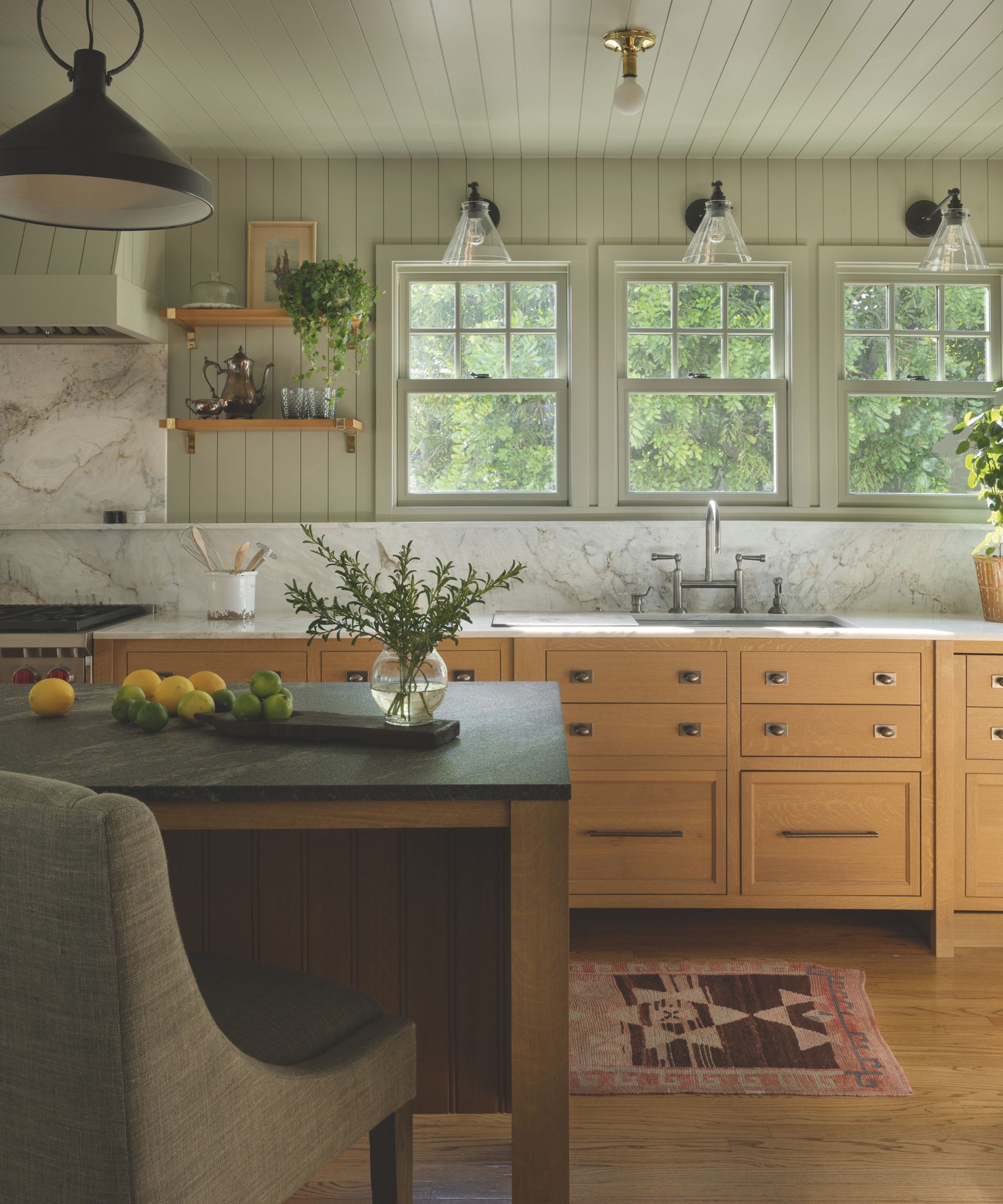
Don’t be afraid to mix metals with kitchen lighting – breaking from uniformity can create a more relaxed, lived-in, layered look. In this warm kitchen scheme, interior designer Denise Morrison paid homage to the home’s 1940s heritage by using vintage-style fittings in various shapes and finishes. Limiting the number of metals to no more than three – in this case, dark bronze, antique brass, and nickel (on the hardware and taps) – helps to prevent a chaotic look.
‘We deliberately avoided minimalist lighting in favor of decorative fixtures,’ says Denise. ‘In particular, the brass flush-mount ceiling design is a stylish substitute for modern recessed lights, enhancing the vintage feel.’
8. Conceal your lighting for a subtle glow
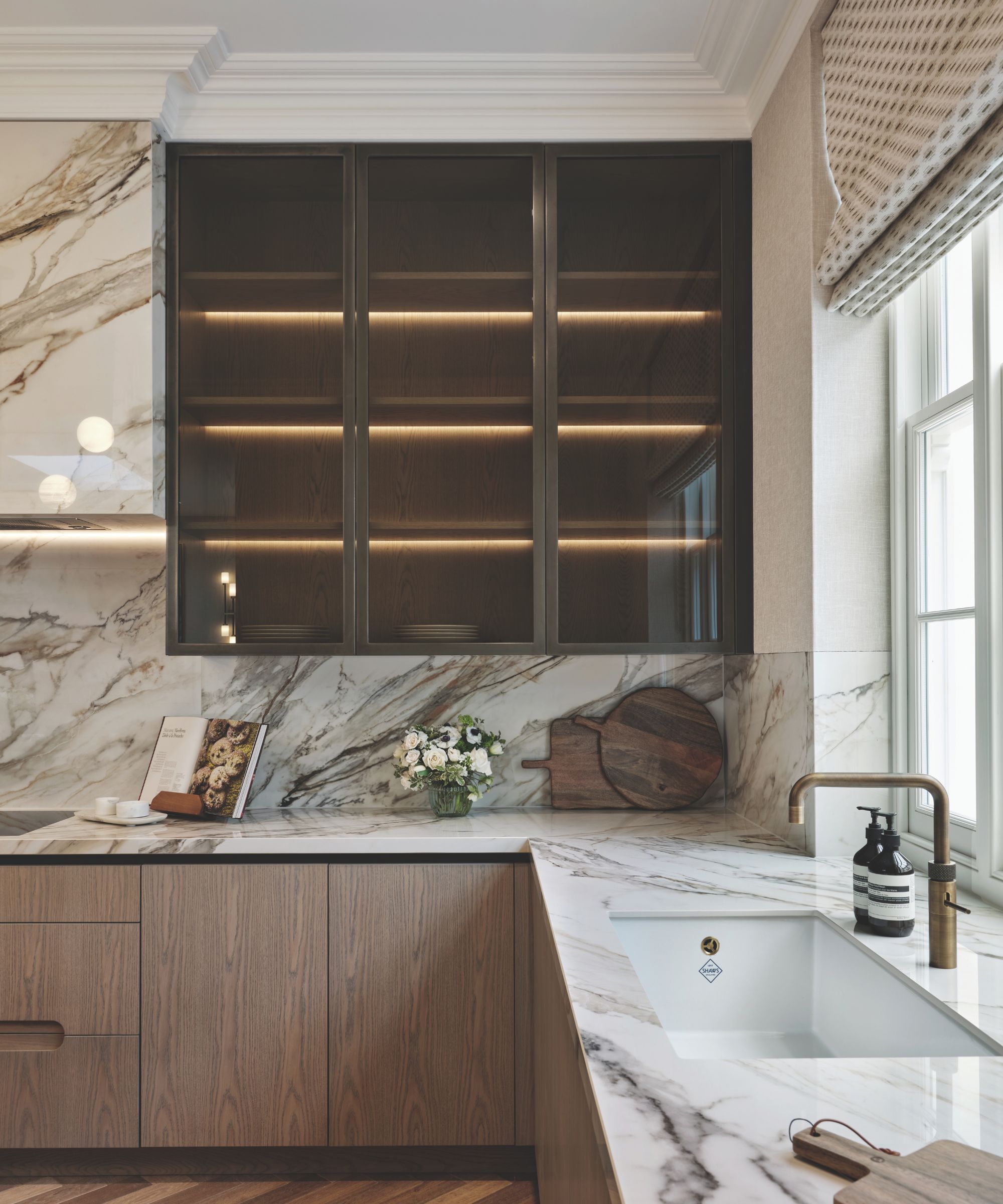
Not all kitchen lighting needs to make a statement. Hidden illumination, where the fittings are concealed and only the soft glow of light can be seen, is a beautiful way to layer more lighting into your scheme without a cacophony of fittings. Langstaff shows how it’s done with this elegantly illuminated glass kitchen cabinet.
‘By concealing LEDs within or behind kitchen shelving, you can subtly integrate the lighting to provide atmospheric illumination and highlight design details, such as a beautiful woodgrain, for example,’ says company director Nick Bell. ‘We always recommend using warm white LED lighting with a color temperature of 2700 Kelvin, as it adds a soft, inviting glow that enhances the warmth and sophistication of the space.’
9. Keep kitchen lighting simple but effective
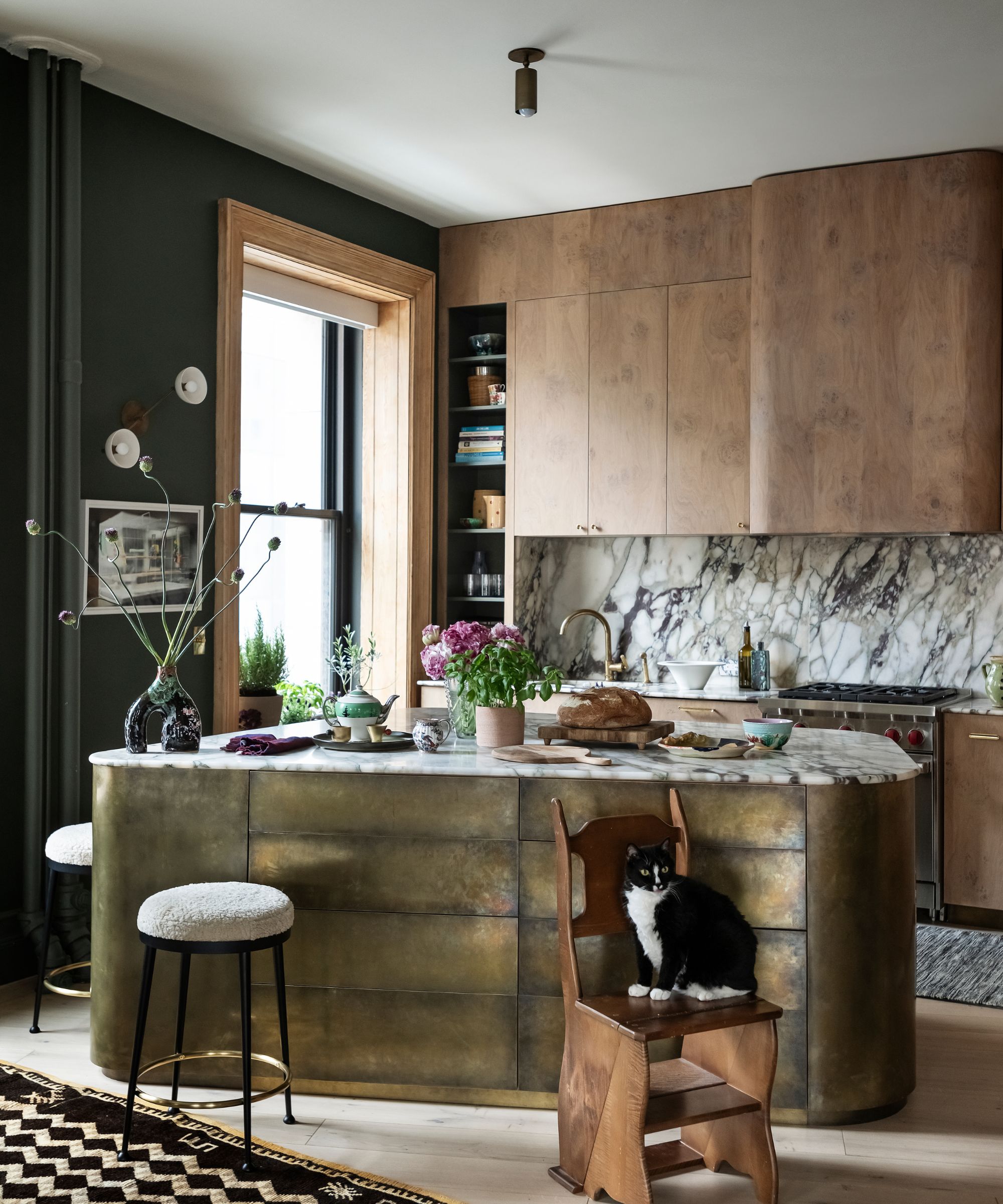
If your kitchen is flooded with natural light, you can pare back on the style of your light fixtures, as can be seen in this Manhattan apartment kitchen designed by Studio DB. This kitchen is filled with beautiful textures and interesting shapes; there's no need for a statement light, so subtle wall lights and downlights were chosen so as not to compete with the rest of the design.
'Our corner kitchen is largely illuminated by the natural light provided by the two large windows and helped by the Apparatus wall sconce come evening,' explains Studio DB partners Damian and Britt Zunino. 'We created this expansive floor-to-ceiling cabinetry, covered in a white oak burl which complements the burnished brass of the kitchen island.'
10. Add wall lights at ceiling level
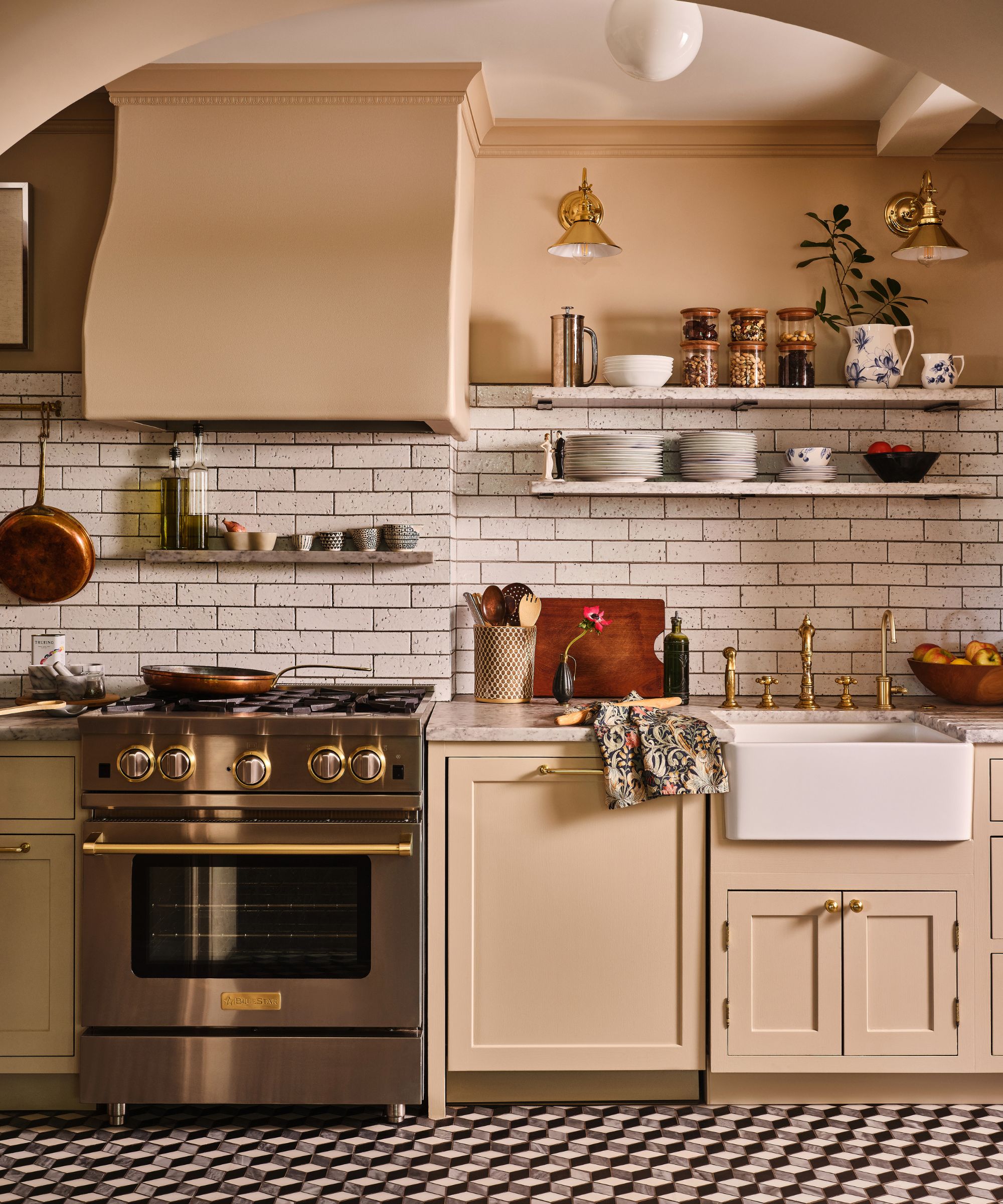
You often see wall lights at eye level; however, mounting them higher up, closer to the ceilings, means they create less of a spot light on your countertops and can illuminate more of the space. They become almost like ceiling lights, but light the edges of the room rather than the center.
In this plaster pink kitchen designed (and owned) by Zoë Feldman adding lights above the shelves made sense to turn them into more of a focal point. The brass finish also ties in perfectly with the fixtures around the sink below.
'The warm, amber-hued tones of the kitchen are provided by the walls painted in Oxford Stone by Farrow & Ball and unlacquered brass fixtures by Rejuvenation. Extra storage is provided by the open shelving that sits above the textured Grove Brickworks backsplash by Waterworks,' explains Zoë.
11. Blend lighting with the cabinet color
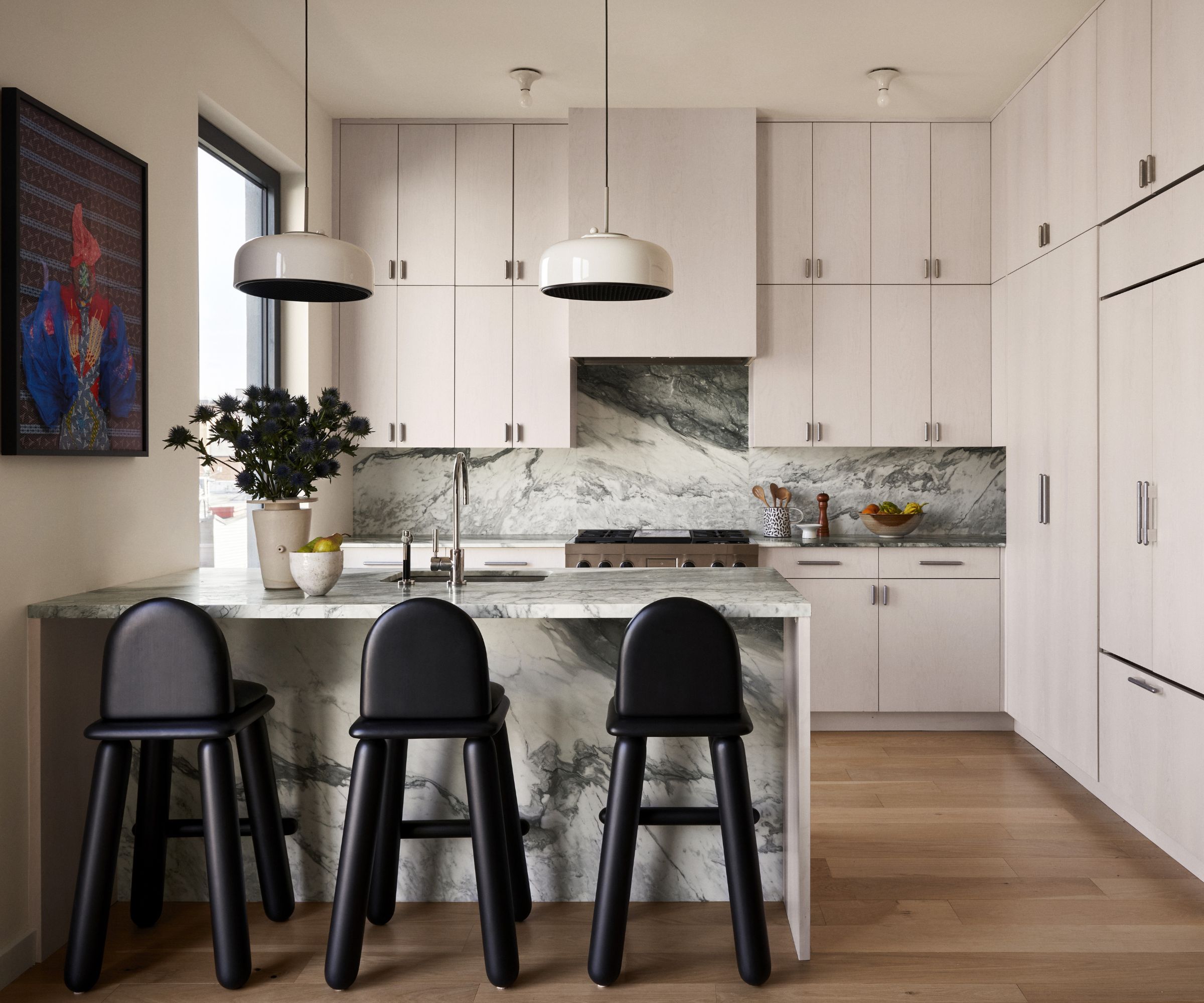
In a smaller kitchen, where you might not want too many elements competing for attention, matching your lighting color to your cabinet color prevents too much visual distraction. In this kitchen designed by White Arrow, the sleek lights almost blend into the background and allow the statement seating and marble island to be the focal point.
We designed these custom floor to ceiling cabinetry in a white bleached maple to infuse a sense of brightness to the kitchen space – which pair well with the white pendants hanging overhead the island by Please Wait To Be Seated,' explains Keren and Thomas Richter, founders of the studio.
12. Go for functional statement lighting
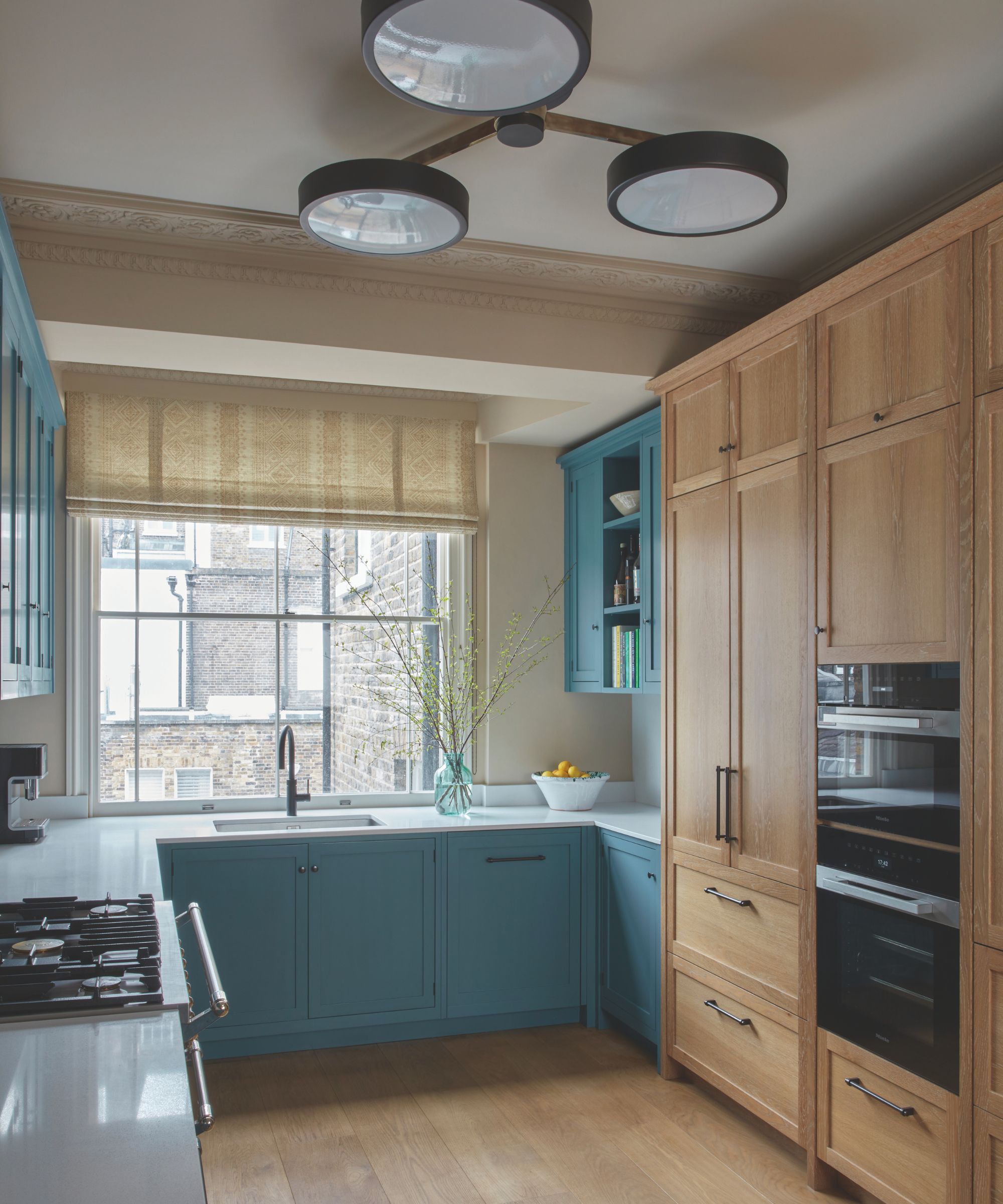
It can take time to track down the perfect kitchen lighting, but perseverance can pay off, as interior designer Kate Guinness attests. For this open-plan space, she employed her best sourcing skills to find a ceiling light for the main part of the kitchen that would provide good general illumination while being a statement piece in itself.
'We wanted something flush to the ceiling, or that wouldn’t hang down too far, since we also have some low pendants elsewhere in the space and didn’t want them to conflict with one another,' Kate explains. This trio of ceiling-hugging lights brings big-scale design energy while maintaining a low profile. ‘It’s the perfect combination of style and function,’ adds Kate.
13. Use kitchen lighting to clearly zone an area
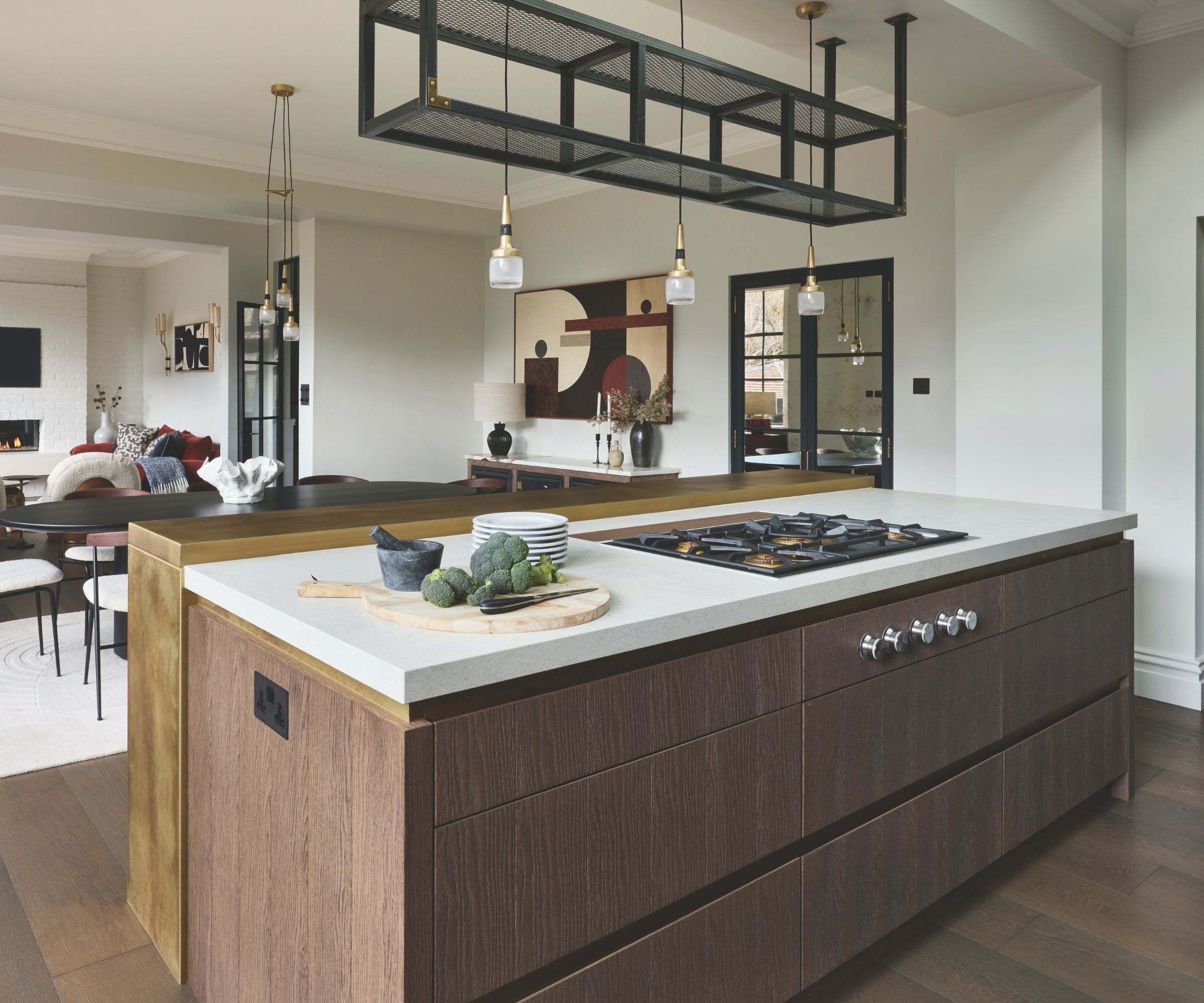
For multifunctional lighting with focal point potential, look to suspended metal-framed shelving. Threaded with three mini pendants, this smart steel unit was designed to zone the kitchen area in the open-plan space, while also targeting task lighting on the island below. ‘It distinguishes the working cooking area from the dining table where the same pendants are used,’ says Mike Fetherston, design director, Hetherington Newman.
When fitting pendants above an island, Mike advises leaving 27-37 inches between the worktop and base of the lights to retain good sightlines. ‘The lights should also have an easy-clean surface such as glass, metal, or enamel rather than fabric as they will pick up grease from cooking over time'.
14. Add character with vintage kitchen lighting
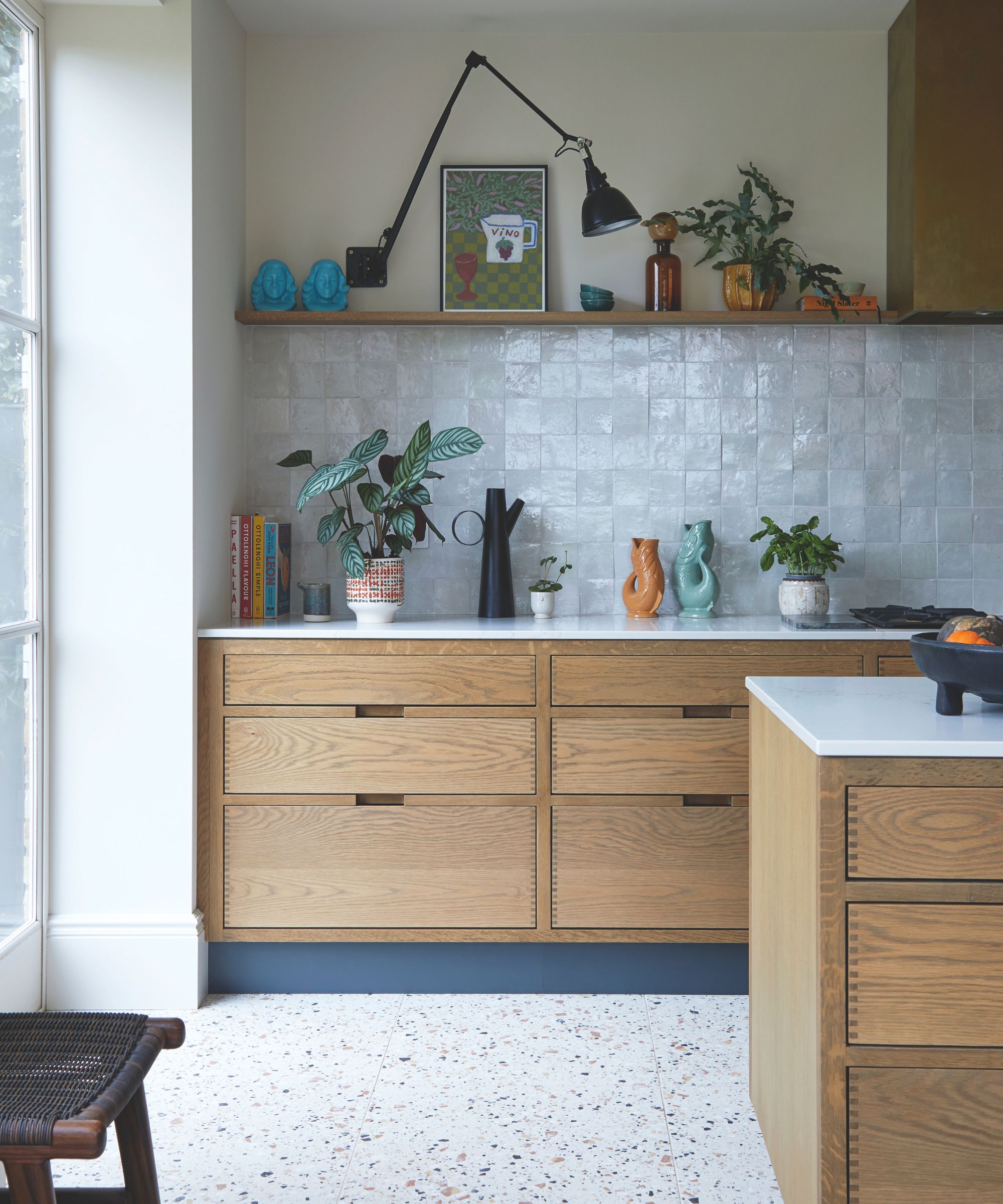
There’s a special joy in bringing vintage lights, with their time-worn charm and sense of history, into your kitchen. ‘Vintage lighting creates a wonderful friction with the newness of a modern kitchen, adding a patina, authenticity, and a story,’ says interior designer Fiona Duke, who sourced this 1940s wall-mounted task lamp by Midgard.
As the wall arm was heavy, Fiona had the backplate changed to a more secure design, and it was rewired by a specialist to comply with safety standards. ‘Besides introducing character, the tractable design of this particular lamp is practical, allowing you to target the light exactly where it’s needed without working in your own shadow,’ Fiona adds.
15. Use lighting to add some playful colors
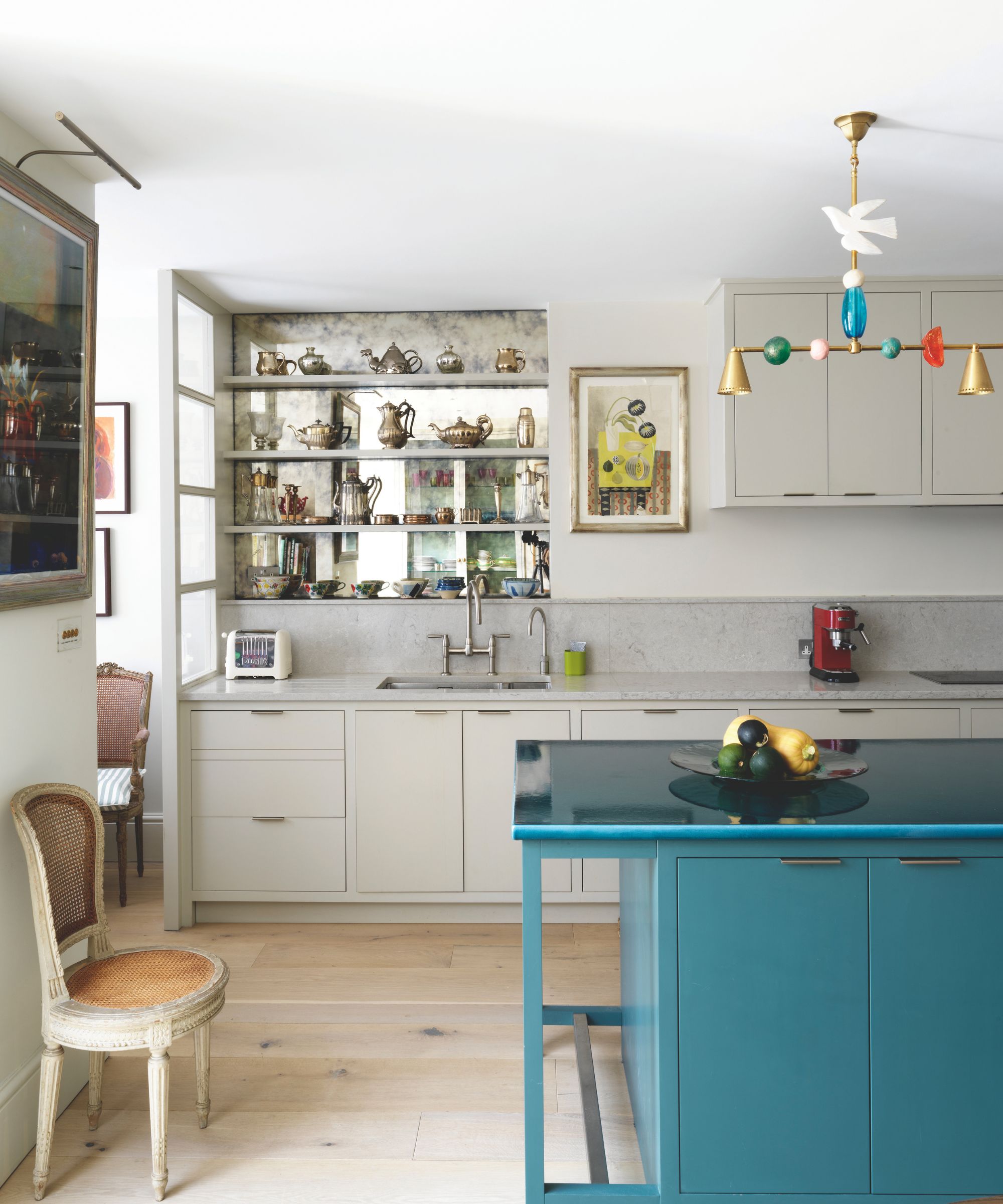
Commissioning a bespoke light fitting from sculptor Margit Wittig was particularly appropriate for this kitchen that belongs to an artist. ‘The walls of the home are lined with sensational watercolors and, knowing Margit’s use of color is exquisite, we worked together to create this sculptural and colorful pendant as the kitchen’s centerpiece,’ says Katie Glaister, founder, K&H Design.
The aim was to create a room where the dining and living experience takes precedence over the kitchen’s functionality. To maximize impact, the light fitting was positioned so it would be reflected both horizontally and vertically in the high sheen of the Pyrolave worktop and the antique mirroring.
16. Create interesting contrasts with a kitchen chandelier
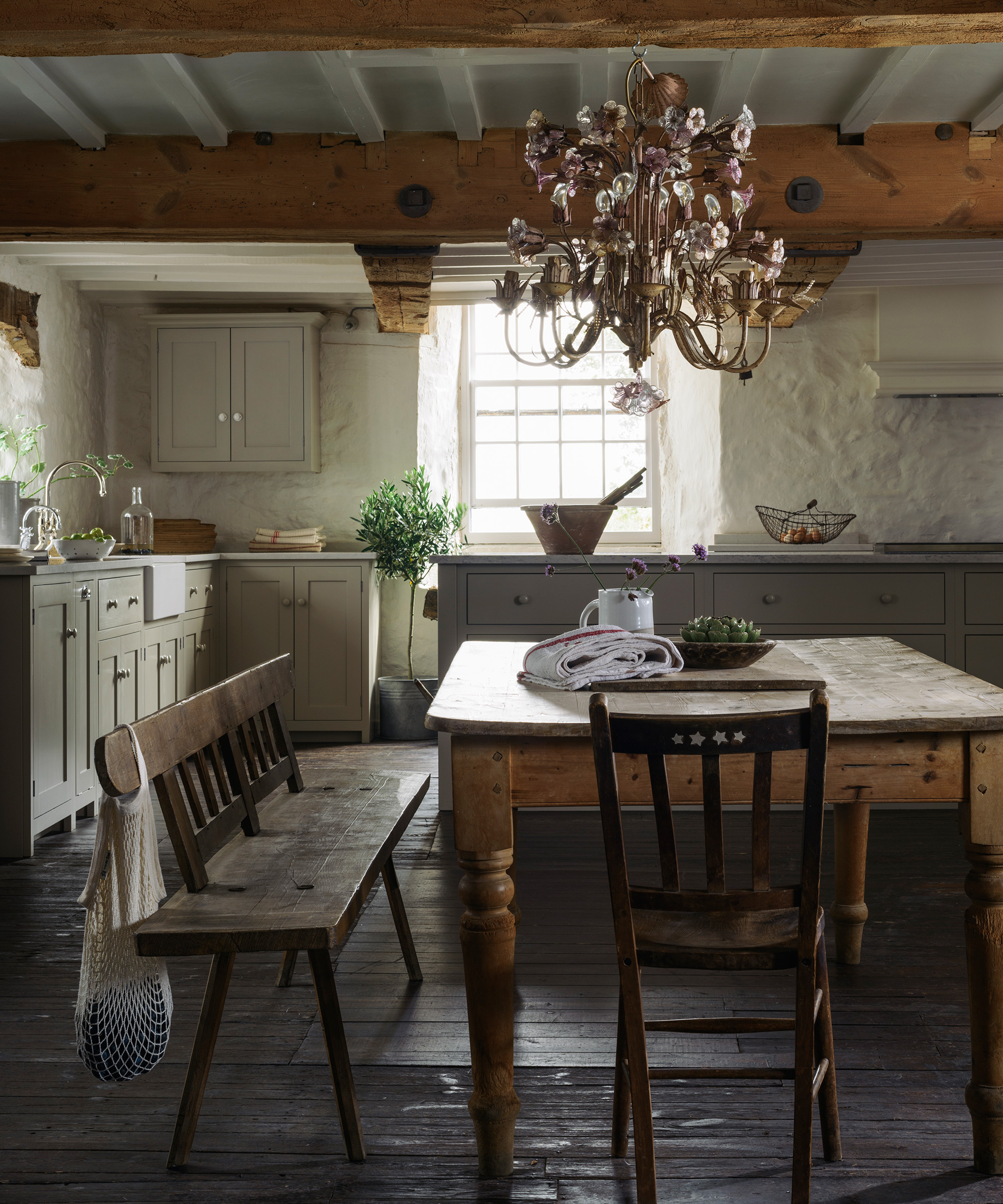
See kitchen lighting like jewelry, it's a way to bring something decorative into your kitchen, add some sparkle to a practical space. And what's the most sparkling of all light fixtures? A chandelier.
I think the lighting is the one place where you can do what you want and what you like, be a bit reckless,' says Helen Parker. 'I reckon a chandelier or an industrial metal look would be equally at home, the key is to stick to the color palette and the simplicity everywhere else in the room, then perhaps, add a little surprise with the lighting.'
'Some people want rustic vibes and love the way rustic fits in with their lifestyle, and yet they crave a bit of frivolity or femininity, color or grandeur, lighting is where they can forget the rules and go off-piste. I absolutely love the idea of raw, humble, and basic for almost everything, but then a surprise sparkle with the lighting, the juxtaposition of this unexpected choice is always what turns a great room into a wow, unexpected room.'
17. Mix your fixtures, but keep it coherent
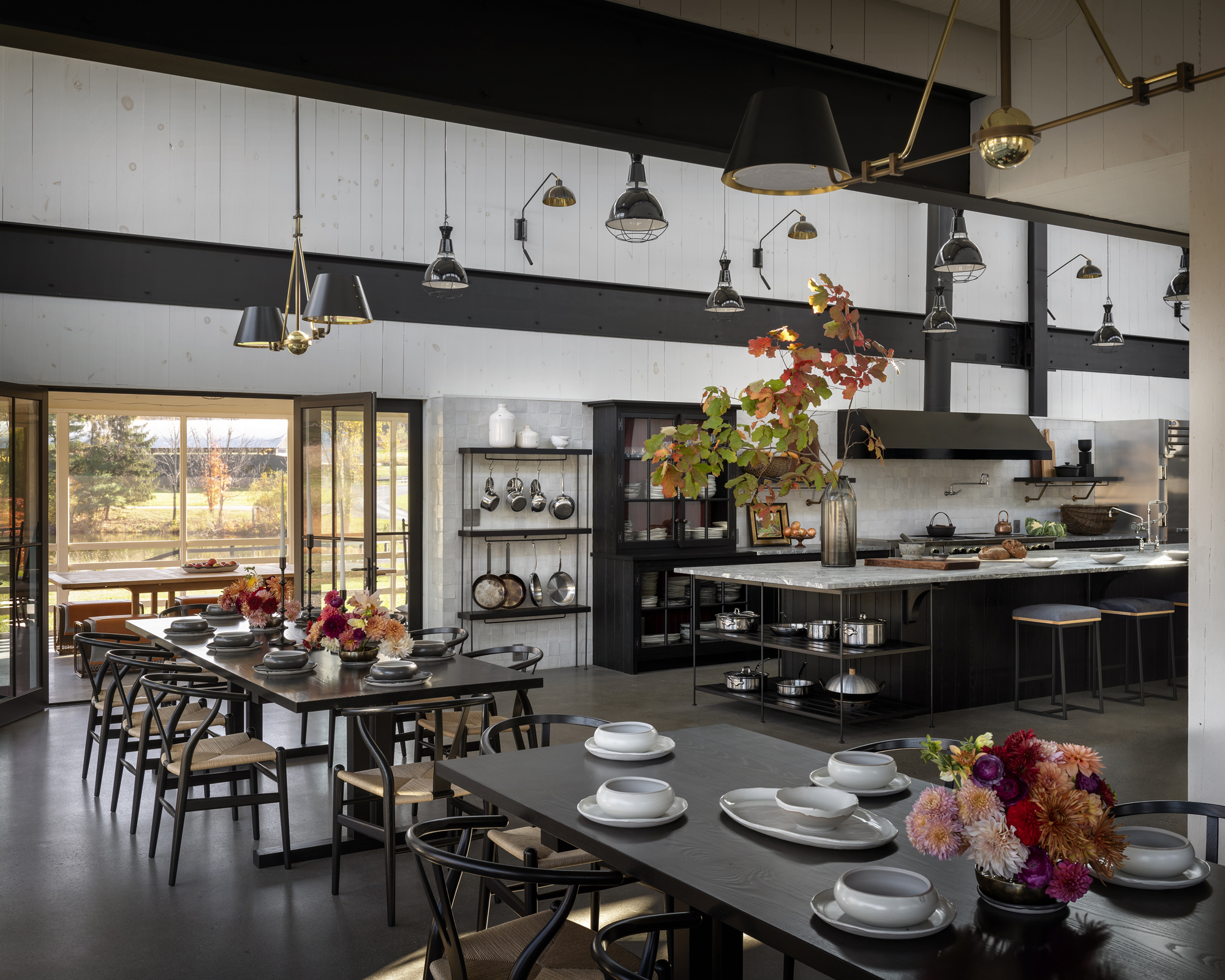
As all kitchens will require multiple different types of lighting, consider exploring a multitude of kitchen lighting trends in your space by mixing and matching different fixtures.
‘Have fun with different shapes and shades, but if you’re mixing it up, stick to a theme or a core tone so that everything hangs together visually,’ says Tom Howley, Design Director of his eponymous kitchen design brand.
This principle is clear in this large barn conversion kitchen by Richard Felix-Ashman, where three differing styles of pendant, chandelier, and wall lighting have been used over the counters, island, and dining tables. All of them feature the color black, with two sporting brass accents, with the entire scheme explores a contemporary take on vintage styles.
18. Create contrast in a scheme with kitchen lighting
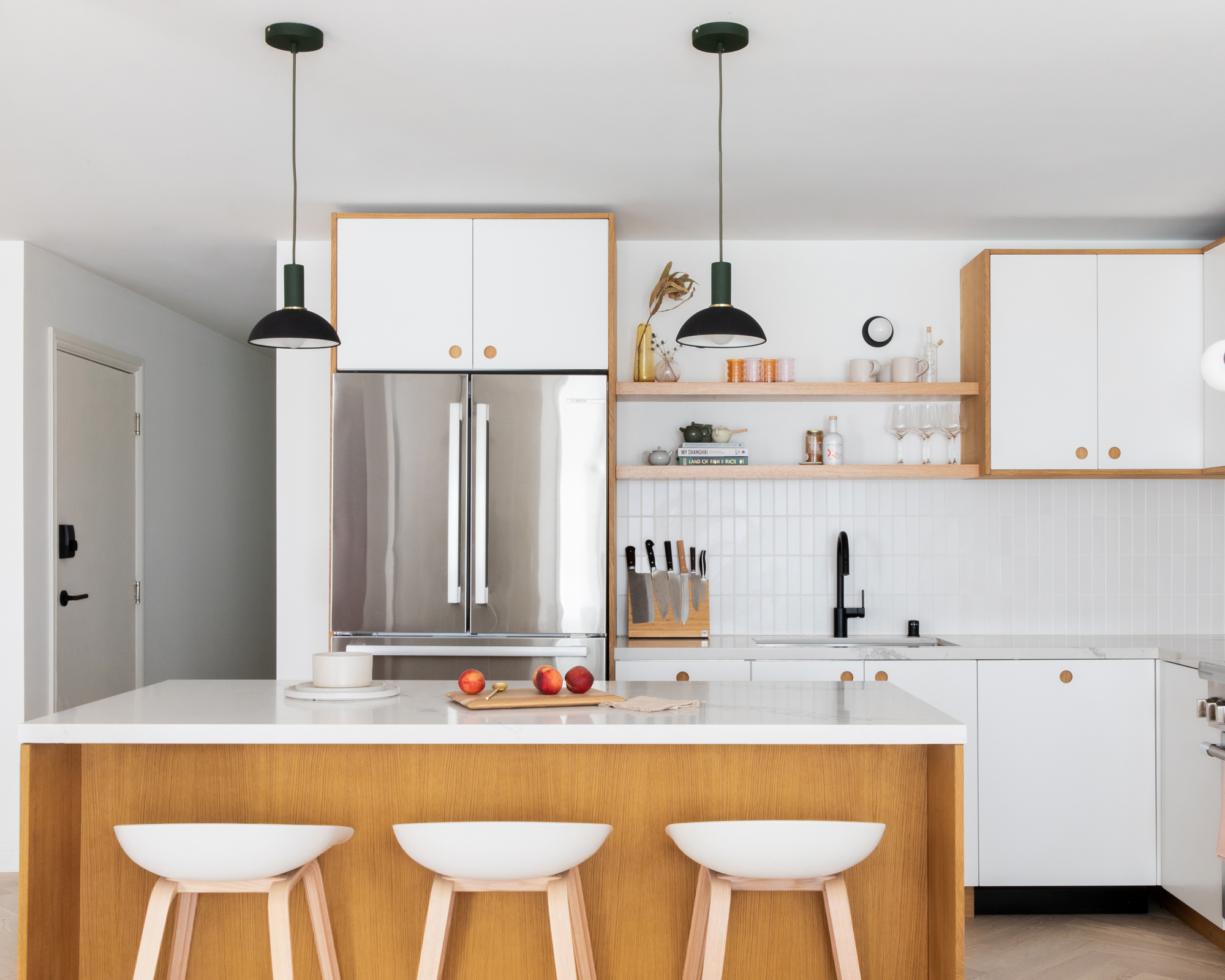
Not only can lighting fixtures make a big impact through their illumination power, but their form can often be the final piece of your kitchen design puzzle that brings everything together.
The modern kitchen lighting ideas used in this San Francisco apartment by Cathie Hong include a pair of black and dark green pendant lights hanging over an island in a kitchen that is largely white and light oak. Along with the faucet, the lights create a standout contrast with their dramatically dark color, adding structure and a thoughtful design touch to the space.
19. Consider a solo light to highlight a focal point
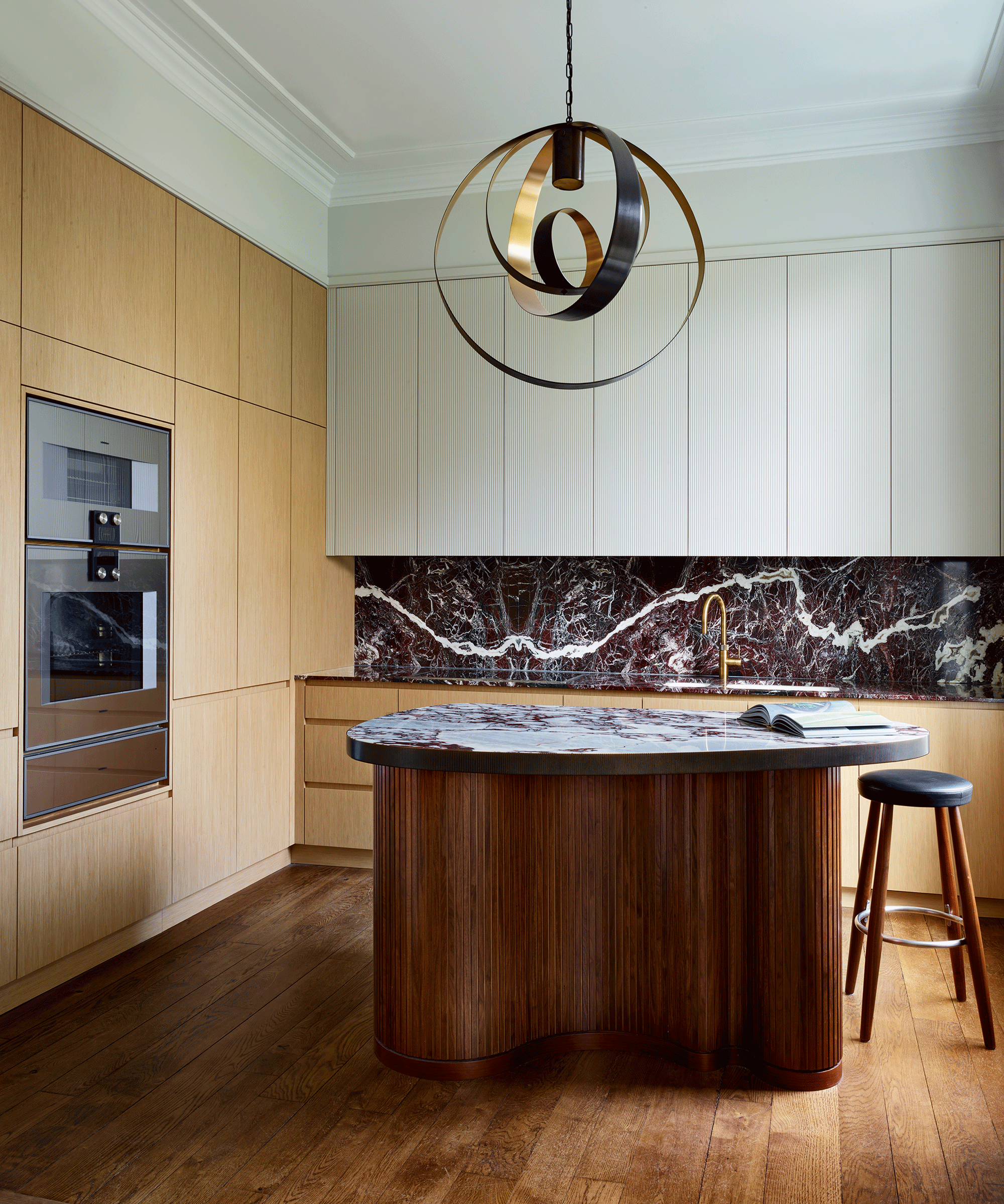
A single designer light poised above an island unit can be all it takes to unite a scheme, inject elegance, and emphasise a focal point, especially in an open plan space.
'If you’re going for one lone fitting, it should be scaled in proportion with the island. Not so big it overpowers, nor so small it looks lost in the space,' says Mike Fetherston, design director at Hetherington Newman. 'Position either centrally if the shape of the island suits, or above a bar seating area. The bottom of the pendant should be clear of head height, so at least 90cm above the worktop.'
20. Oversize your pendants
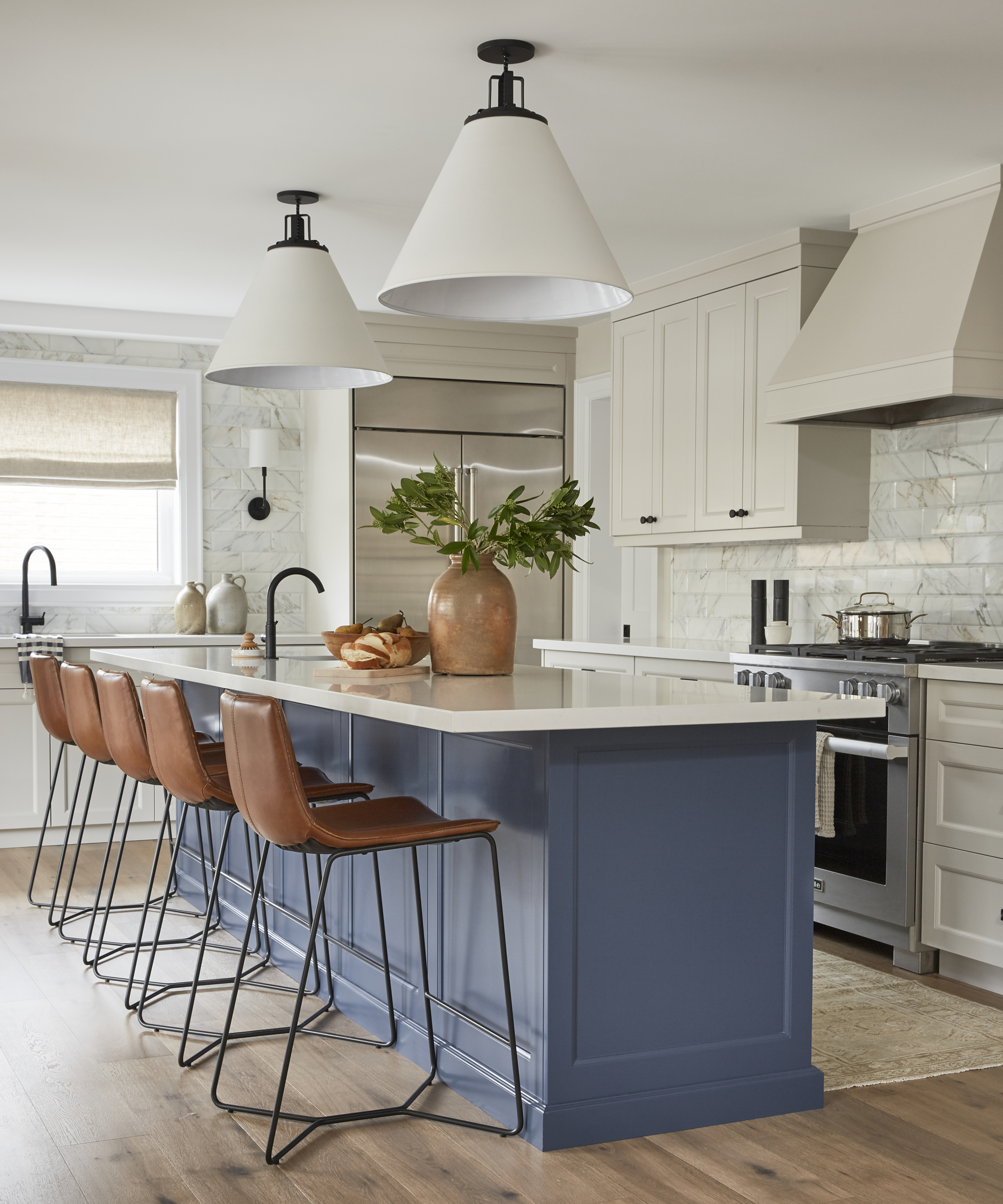
When thinking about how to plan kitchen lighting, don’t be afraid to go big. Daringly oversized lighting features are a great way to add character to a kitchen – just be sure to position them carefully.
In this kitchen by Tiffany Leigh, oversized lampshades hang from the ceiling over the island – their positioning maximizes task lighting over the workspace, while also creating a widespread warm glow at the center of the room. Crucially, they are kept high enough not to interfere with the eyeline, and add a quirky touch thanks to their slightly surreal size.
21. Incorporate reflective materials to bounce light around the room

When thinking about how much light your kitchen needs, it’s important to consider a balance of natural light and artificial light. One trick you can use to enhance both – day or night – is to incorporate reflective surfaces into your design.
In this kitchen by Liz Caan, brass metallic accents glow in the sunlight, glass cabinet doors reflect light in the darker lower areas of the kitchen, while a mirror next to the window and a statement mirrored ceiling light create a glistening jewel at the center of the room.
22. Group smaller, understated lights for a more dramatic impact
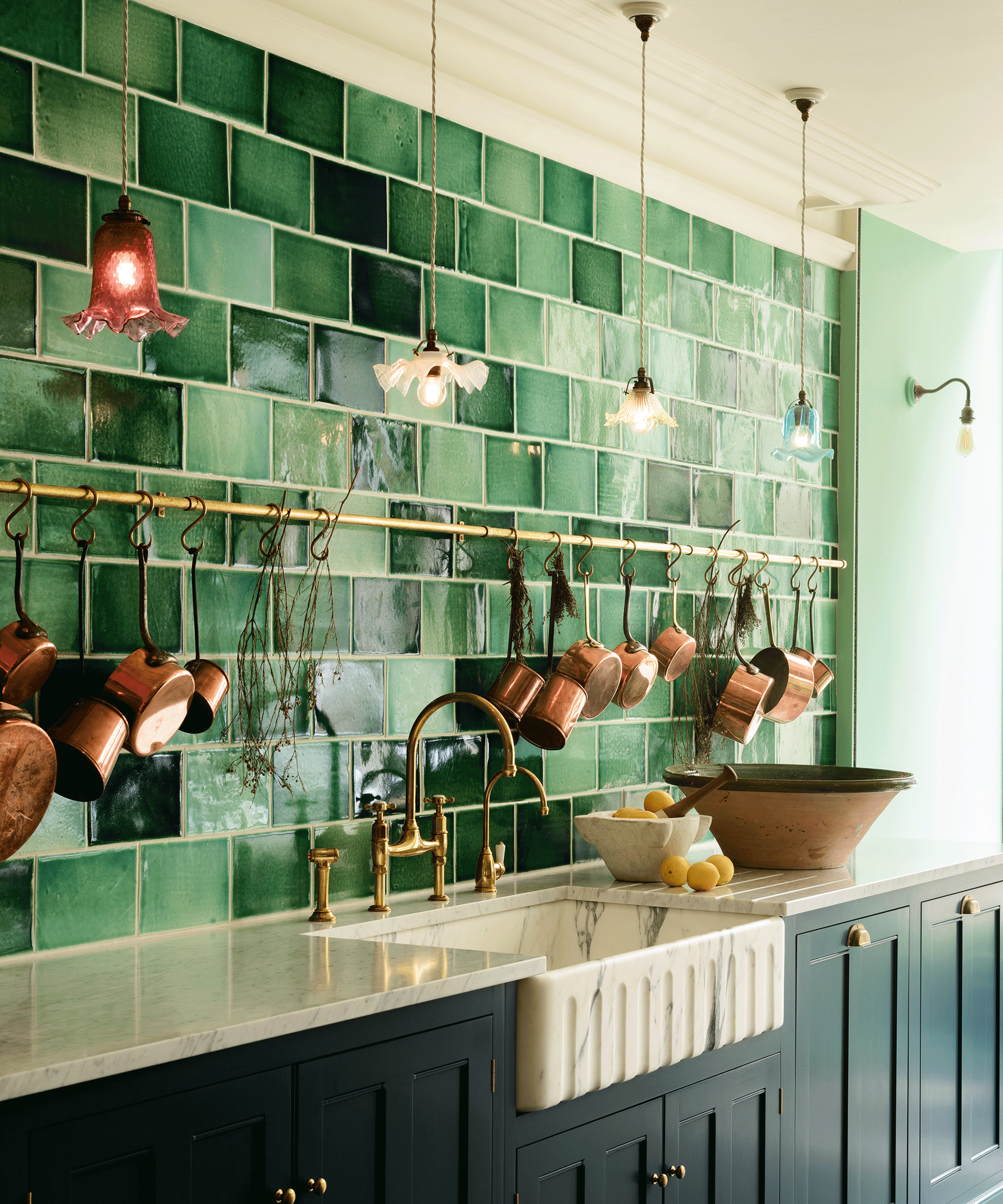
The unexpected positioning of these pretty vintage pendants elevates their appeal. It also bears practical benefits, bringing the light source closer to the task in hand. The elegance and jewel-like colors of these antique glass pendants are unique, but the shades have been visually united using matching retro fittings. Individually, they may be small and dainty, but when they work together, they feel far bolder and are far more practical too.
'You can easily tire of statement lighting that dominates the kitchen,' says Helen Parker. 'Discreet and understated designs still catch our attention, but we don’t get bored of them so easily.'
23. Choose different lighting styles to differentiate different areas
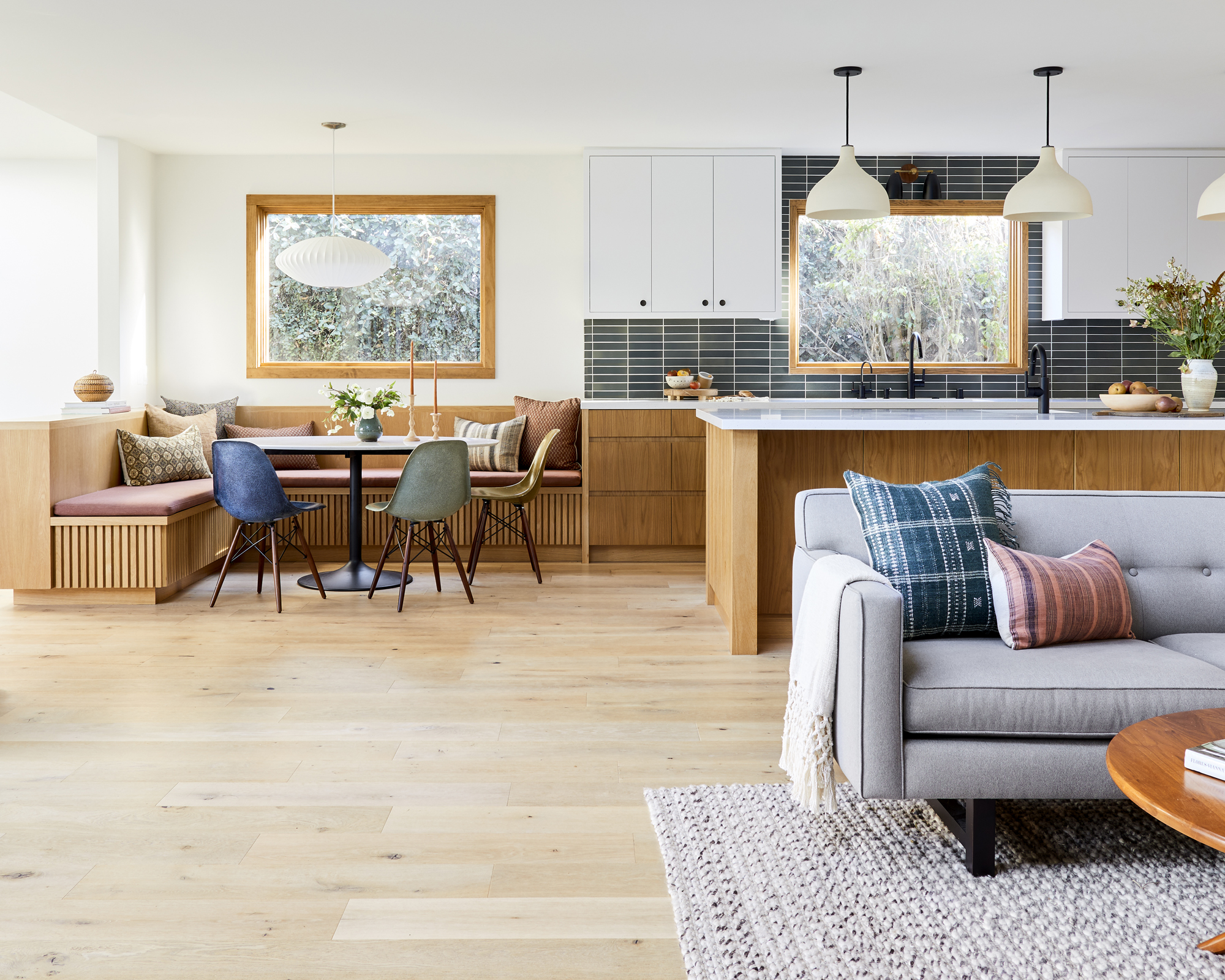
When considering how to choose kitchen lighting, it’s important to match the appropriate style to its location in the room. Adding extra light to a dining area is a great way to boost atmosphere and make sure your culinary creations look their best when served, and pendant lights hung from the ceiling do this while also creating an unmissable design feature.
In this kitchen by designer Ginny Macdonald, pendants are used over both the island and the breakfast area. Their low hanging nature means they are always best used over a table or counter, where people aren’t going to walk underneath them.
24. Give unique nooks dedicated lighting
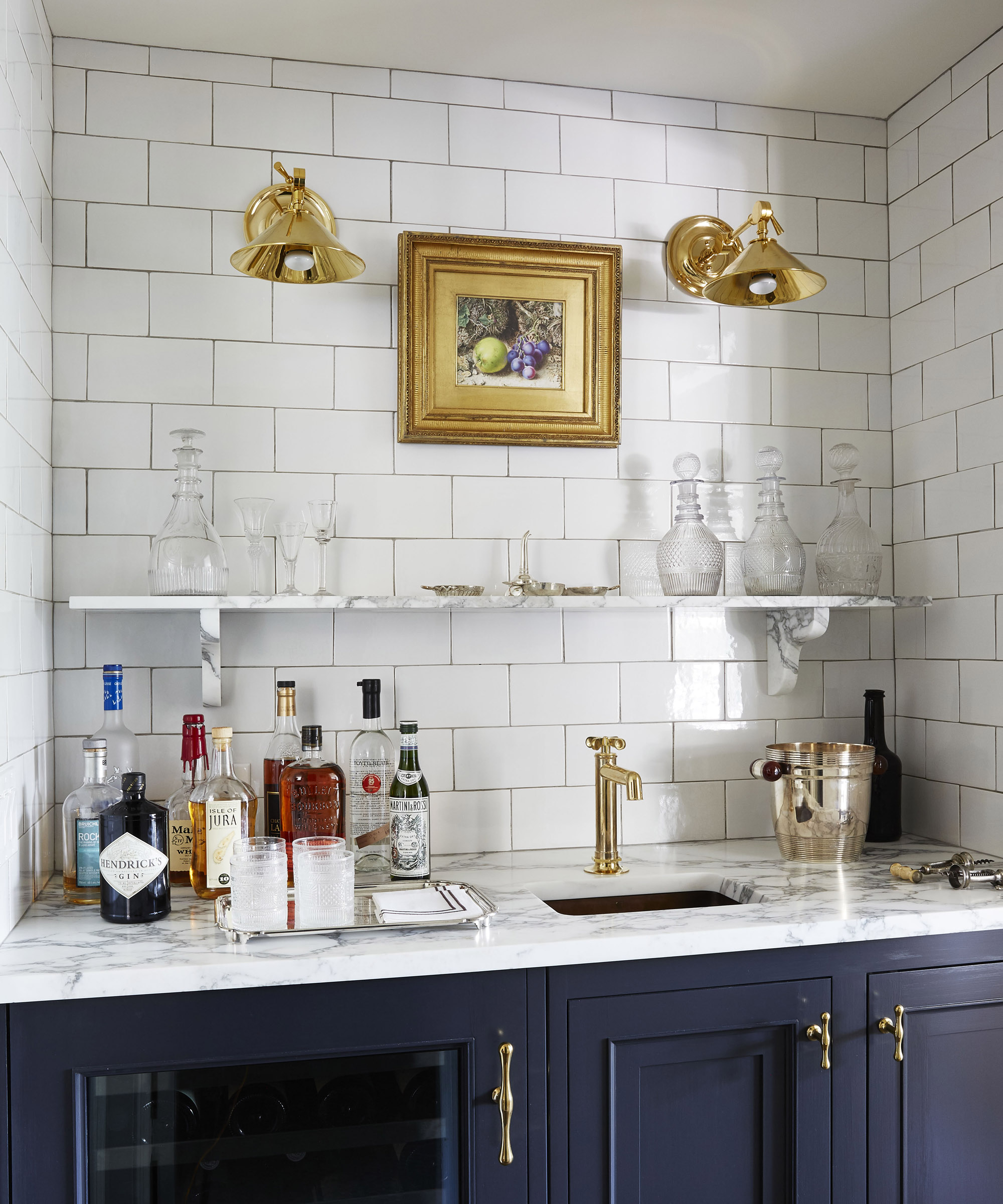
Recessed areas and alcoves can be great spaces to turn into dedicated areas for certain functions, like a home bar or coffee station, but they can also end up being a little darker if tucked away from the room’s main lights.
In this kitchen owned by Waterworks Co-Founder Barbara Sallick, an alcove has been turned into a bar area, deliberately lit with its own brass wall sconces to ensure home bartenders can work their magic with ease. Lighting can give these spaces more character too – you can be more playful with your lighting here.
25. Light up a pantry
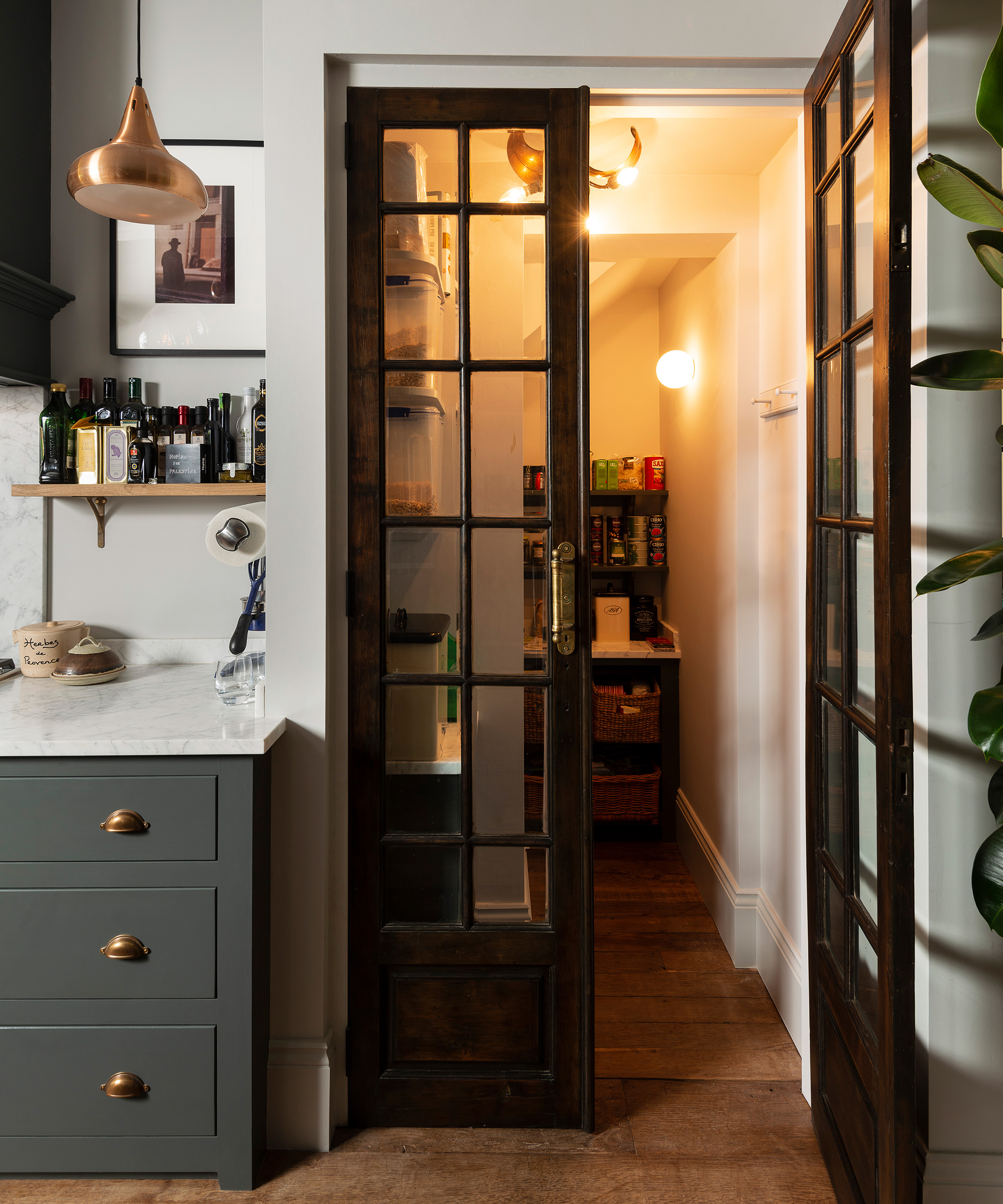
If you have a walk in pantry, you need to consider its lighting much like your kitchen. Like a kitchen, this space needs to be practical first and foremost, and a mixture of ceiling and wall lighting usually works best. Nothing too ornate that's going to hang down or stick out into the space.
You could also add LED strips underneath shelving or in cabinets, which are ideal task lights in a pantry. You might want to consider making some of your lighting motion-activated, too, as these rooms often don't have windows, having a light switch on as soon as you walk in the space can be helpful.
Most of your kitchen lighting ideas should be planned in right from the beginning of your remodel. But that's not to say you can't switch them out as kitchen trends change, or add new lighting fixtures like lamps to soften your scheme.







